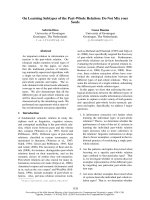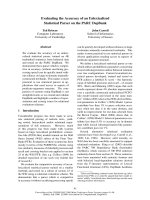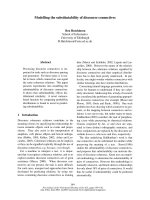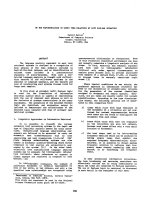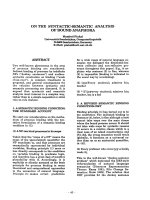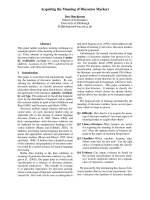Báo cáo khoa học: "ON THE INDEPENDENCE OF DISCOURSE STRUCTURE AND SEMANTIC DOMAIN" docx
Bạn đang xem bản rút gọn của tài liệu. Xem và tải ngay bản đầy đủ của tài liệu tại đây (253.73 KB, 4 trang )
ON THE INDEPENDENCE OF DISCOURSE STRUCTURE
AND SEMANTIC DOMAIN
Charlotte Linde ~ J.A. Goguen + *
I. THE STATUS OF DISCOURSE STRUCTURE
Traditionally, linguistics has been concerned with units
at the level of the sentence or below, but recently, a
body of research has emerged which demonstrates the
existence and organization of linguistic units larger
than the sentence. (Chafe, 1974; Goguen, Linde, and
Weiner, to appear; Grosz, 1977; Halliday and Hasan, 1976;
Labov, 1972; Linde, 1974, 1979, 1980a,198Cb; Linde and
Goguen, 1978; Linde and Labov, 1975; Folanyi, 1978;
Weiner, 1979.) Each such study raises a question about
whether the structure discovered is a property of the
organization of Language or whether it is entirely a
property of the semantic domain. That is, are we discov-
ering general facts about the structure of language at a
level beyond the sentence, or are we discovering
particular facts about apartment layouts, water pump
repair, Watergate politics, etc? Such a crude question
does not arise with regard to sentences. Although much
of the last twenty years of research in sentential
syntax and semantics has been devoted to the investigat-
ion of the degree to which syntactic structure can be
described independently of semantics, to our knowledge,
no one has attempted to argue that all observable
regularities of sentential structure are attributable to
the structure of the real world plus general cognitive
abilities. Yet this claim is often made about regular-
ities of linguistic structure at the discourse level.
In order =o demonstrate that at leas= some of the
structure found at the discourse level is independent
of the structure of the semantic domain, we may show
that there are discourse regularities across semantic
domains. As primary data, we will use apartment layout
description, small group planning, and explanation.
These have all been found to be discourse units, that
is, bounded linguistic units one level higher than the
sentential level, and have all been described within
the same formal theory. It should be noted that we do
not claim that the structures found in these discourse
units is entirely independent of structure of the
semantic domain, because of course the structure of the
domain has some effect.
2. TREE TRANSFORMATIONS IN DISCOURSE PRODUCTION
The discourse units mentioned above have all been found
to be tree structured. This is a claim that any such
discourse can be divided into parts such that there
are significant relations of dominance among these parts.
These trees can be viewed as being constructed by a
sequence of transformations on an initial empty tree,
with each transformation corresponding to an utterance
by participants, which may add, delete, or move nodes
of the tree. The sequence of transformations encodes
the construction of the discourse as it actually
proceeds in time.
We now turn to a discussion of the discourse units
which have been analysed according to this model.
* Structural Semantics, P.O. Box 707, Palo Alto,
California 94302.
+ SRI International, 333 Ravenswood Ave., Menlo Park,
California 94025.
2.1 SPATIAL DESCRIPTIONS AS TOURS
In an investigation of the description of spatial
networks, speakers were asked to describe the layout of
their apartment. The vast majority of speakers used a
"tour strategy," which takes the hearer on an imaginary
tour of the apartment, building up the description of
the layout by successive mention of each room and its
position. This tour forms a tree composed of the entry
to the apartment as root with the rooms and their
locations as nodes, and with an associated pointer
indicating the current focus of attention, expressed by
unstressed you.
It might be argued that the tree structure of these
descriptions is a consequence of the structure of
apartments rather than of the structure of discourse.
However, there are apartments which are not tree
structured, because some rooms have more than one
entrance, thus allowing multiple routes to the same
point; but in their descriptions, speakers traverse only
one route; that is, loops in the apartment are always
cut in the descriptions. [ Thus, although some of the
tree structure may be attributable to the physical
structure being described, some of it is a consequence
of the ease of expressing tree structures in language,
and the difficulty of expressing graph structures.
The tree structure of apartment descriptions is construc-
ted using only addition transformations, and pointer
movement transformations (called "pops" in tinde and
Goguen (1978)) which bring the focus of attention back
from a branch which has been traversed to the point of
branching. The construction of the tree is entirely
depth first.
2.2 SPATIAL DESCRIPTIONS AS MAPS
In describing apartment layouts, there is a minority
strategy, used by 4% of the speakers (3 out of 72 cases
of the data of Linde (1974)) describing the layout in
the form of a map. The speaker first describes the
outside shape, then sketches the internal spatial
divisions, and finally labels each internal division.
This strategy can also be described as a tree
construction, in this case, a breadth first traversal
with the root being the outside shape, the internal
divisions the next layer of nodes, and the names of
these divisions the terminal nodes. Because there are
so few example, it is not possible to give a detailed
description of the rules for construction.
2.3 PLANNING
We have argued that the structure of apartment layout
descriptions is not entirely due to the structure of the
semantic domain; however, a question remains as to
whether it is the restriction to a limited domain which
permits precise description. To investigate this, let
us consider the Watergate transcripts, which offer a
spectacularly unrestricted semantic domain, specifically
those portions in which the president and his advisors
engage in the activity of planning. (Linde and Goguen,
1978). Planning sessions form a discourse unit with
"[ In more mathematical language, the linear sequence of
rooms is the depth first traversal of a minimal spanning
tree of the apartment graph.
35
discernable boundaries and a very precisely describable
internal structure. Although we can not furnish any
detailed description of the semantic domain, we can be
extremely precise about the social activity of plan
construction.
Because the cases we have examined involve planning by a
small group, the tree is not constructed exclusively by
addition, as are the types discussed above. Deletion,
substitution, and movement also occur, as a plan is
criticised and altered by all members of
the group.
Z.4 EXPLANATION
A discourse unit similar to planning is explanation.
(Weiner, 1979; Goguen, Linde and Weiner to appear.) (By
explanation we here include only the discourse unit of
the form described below; we exclude discourse units
such as narratives or question-response pairs which may
socially serve the function of explanation.) Informally,
explanation is that discourse unit which consists of a
proposition to be demonstrated, and a structure of
reasons, often multiply embedded reasons, which support
it. The data of this study are accounts given of the
choice to use the long or short income tax form,
explanations of career choices, and material from the
Watergate transcripts in which an evaluation is given
of how likely a plan is to succeed, with complex
reasons for this evaluation.
Like apartment descriptions and small group plan-
ning, explanation can be described as the transforma-
tional construction of a tree structure. Since in the
casesexauLined, a single person builds the explanation,
there are no reconstructive transformations such as
deletion or movement of subtrees; the transformations
found are addition and pointer movement. Pointer
movement is particularly com~lex in this discourse unit
since explanation permits embedded alternate worlds,
which require multiple pointers to be maintained.
Explanation structure appears to be the same in the
three different semantic domains, suggesting that the
discourse structure is due to genral rules plus a
particular social context, rather than being due to the
structure of the semantic domain.
3. CRITERIA FOR EVALUATING DISCOURSE STRUC%~/RES
The
criticism
might
be
made
of these tree structures
that an analyst can impose a tree structure on any
discourse, without any proof that it is related to
what the speaker himself was doing. We would claim that
although we have, of course, no direct access to the
cognitive processes of speakers, there are two related
criteria for evaluating a proposed discourse structure.
3. I TEXT MARKING
One
criterion for Judging
the
relative naturalness of
a
particular analysis is the degree to which the text
being analysed contains markers of the structure being
postulated. Thus, we have some confidP-ce that the
speaker himself is proceeding in terms of a branching
structure when we find markers like "Row as you're
coming into the front of the apartment, if you go
straight rather than go right or left, you come into a
large living room area," or "On the one hand, we could
try " The opposite case would be a text in which
the division postulated by an analyst on the basis of
some a priori theory had no semantic or syntactic
marking in the text.
3.2 FRUITFULNESS OF THE ANALYSIS
A second criterion is whether some postulated
structure is fruitful in generating further suggestions
for how to explore the text. Thus, the tree analyses of
apartment layout descriptions, planning, and explanation,
give rise to questions such as how various physical layouts
are turned into trees, how trees are ~raversed, the social
consequences of particular transfoz~l~ions, the apparent
psychological ease or difficulty of various transformations,
the relation of discourse structure to syntactic structure,
etc. (see Linde and Goguen, 1978) By contrast, an
unfruitful analysis will give rise to few or no interesting
research questions, and will not permit the analyst to
investigate questions about the discourse unit which he or
she has reason to believe are in,cresting.
4. GENERAL PRINCIPLES OF DISCOURSE STRUCTURE
Given that ~hese postulated structures are useful models
of what speakers do, we may ask how it is that speakers
produce texts with these structures. It is known that
children must learn to produce well-formed narratives.
It
might be
hypothesized that each discourse unit must
be separately learned, and that each has its own unrelated
set of rules. However, there is evidence that there are
verT general rules for discourse construction, which hold
across discourse units,
and
which can
be
used ~o
construct
novel discourse units. The test case for such a
hynuthesls is the production of a discourse unlt whlch
is not a part of speakers' ordinary repetolre, but
rather, is made up for the occasion of the experiment.
Such an experiment was performed by asking people to
describe the process of getting themaelves and their
husbands and children off to work in the morning. (Linde,
in preparation) These "morning routines" are typically
well-structured and regular; everyone appears to do
them the same way. We know that the speakers had never
produced such discourses before, since we never in
ordinary discourse hear such extended discussions of
the details of daily llfe. (Even bores have their
limits.) Therefore, the regularities must be the
product of the intersection of a particular real world
domain, in this case, multiple parallel activities, with
very general rules for discourse construction. 2
4.1 META-RULES OF DISCOURSE STRUCTURE
We are by no means ready to offer a single general
theory of discourse structure; that must wait until
a sufficiently large number of discourse types has been
investigated in detail. However, the following rules
have been observed in two or more discourse units, and
it is rules of this type that we would llke to investl-
gate in other discourse units.
[. The
most frequent subordinator for a given
discourse unit will have the most minimal
marking in the text, most frequently being
marked with lexical and. Moreover, it will not
be necessary to establish this node before
beginning the first branch, but only when the
return to the branch point is effected.
2. All other node types which subordinate two or
more branches, such as exclusive or or
conditional, must be indicated by markers in
the text before the first branch is begun.
3. Depth-first traversal is the most usual strategy.
4. Pop markers are available to indicate return to
a branch point or higher node; it is never
necessary to recapitulate in reverse the entire
traversal of a branch.
Z
This is interesting for the light which it sheds on
natural structures for the description of concurrent
activities.
36
5. CONCLUSIONS
The reason for being interested in regularities of
• discourse structure, particularly regularities which hold
across a number of discourse types, is that they suggest
universals of what is often called "mind," and, more
practically, they also suggest features which might be
part of systems for language understanding and production.
Indeed Welner (to appear) has constructed a system for the
production of explanations of U.S. income tax law based
on the transformational theory of explanation discussed
in section 2.4. There is, moreover, the possibility of
designing meta-systems, which might be programmed to
handle a variety of discourse types.
ACKNOWLEDGEMENTS
We would like to thank R. M. Burstall and James Weiner
for their help throughout much of the work reported in
this paper. We owe our approach to discourse analysis
to the work of William Labor, and our basic orientation
to Chogyam Trungpa, Rinp~che.
REFERF.NCES
Chafe, Wallace, 1974. Language and Consciousness.
Language. Vol. 50, 111-133.
Goguen, J.A., Charlotte Linde, and James Weiner. to
appear. The Structure of Natural Explanation.
Grosz, Barbara J. 1977. The Representation and Use 9f
Focus in Dialogue Understanding. SRI Technical Note 151.
Hal~iday, M.A.K. and Ruqaiya N. Hasan, 1976. Cohesion
in English, Longman, London.
Labor, William, 1972. The Transformation of Experience
into Narrative Syntax, in Language in the Inner City,
Philadelphia, University of Pennsylvania Press.
Linde, Charlotte, 1974. The Linguistic Encoding of
Spatial Information. Columbia University, Department of
Linguistics dissertation.
Linde, Charlotte, 1979. Focus of Attention and the Choice
of Pronouns in Discourse, in Syntax and Sem~ntlcs, Vol.12
Discourse and Syntax~ ed. Talmy Givon, Academic Press,
New York.
Li~de, Charlotte, 1980a. The Organization of Discourse,
in The English Language in its Social and Historical
Context ed. Timothy Shopen, Ann Zwlcky and Peg Griffen,
Winthrop Press, Cambridge, Massachusetts.
Linde Charlotte, 1980b. The Life Story: A Temporally
Discontinuous Discourse Type, in Papers From the Kassel
Workshop on Psycholingulstic Models of Production.
Linde, Charlotte, in preparation. The Discourse Structure
of the Description of Concurrent Activity.
Linde, Charlotte and J.A. Goguen, 1978. The Structure
of Planning Discourse, Journal of Social and Biological
Structures, Vol. [, 219-251.
Linde, Charlotte and William Labor, 1975. Spatial
Networks as a Site for the Study of Language and Thought,
Language , Vol. 51, 924-939.
Polanyi, Livia, 1978. The American Story. University of
Michigan Department of Linguistics dissertation.
Weiner, James, 1979. The Str~cture of Natural
Explanation: Theory and Application. System
Development Corporation, SP-4035.
Welner, J. BLAH: A System Which Explains its Reasoning,
tO appear in Artificial Intelli~ence.
37

